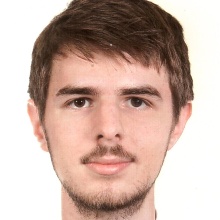Lars von Wolff, doctoral researcher at the Institute of Applied Analysis and Numerical Simulation (IANS), and member within the framework of SFB 1313 and the Integrated Research Training Group IRTG-IMPM, will defend his dissertation:
Title: "The Phase Field Approach for Reactive Fluid-Solid Interfaces: Modeling and Homogenization"
Date: 22 September 2022
Time: 10 am CET
Venue: Aula 8.122, Pfaffenwaldring 57, 70569 Stuttgart, Campus Vaihingen
Abstract
The overarching topic of this dissertation is multi-phase flow in porous media. In the presence of salts and their ions, precipitation and dissolution can alter the pore-space and have a great impact on flow through porous media. Therefore, we need reliable models that can describe these effects accurately both on the pore-scale and on larger scales.
In this dissertation, we first propose several pore-scale models for multi-phase flow including reactive fluid–solid interfaces. In these models, both fluid–fluid and fluid–solid interfaces are resolved as diffuse interfaces using the phase field method. We investigate the thermodynamical consistency of the models and find their sharp interface limit using asymptotic analysis.
We proceed to upscale the pore-scale models either using homogenization in a periodic porous medium or transversal averaging in the simplified geometry of a thin strip. The results are multi-scale models consisting of averaged equations for flux and ion concentration, with parameters that have to be determined through cell problems. These cell problems encode information about the geometry of the microscale at each macroscopic point.
Lastly, we apply the developed models to investigate enzymatically induced calcite precipitation. We compare simulation results to micro-fluidic experiments and find excellent agreement, in particular for the growth direction of crystal aggregates.


